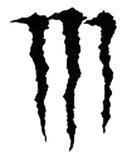Monster mashed
Chris Hawkes explains why a huge reputation will not always help.

B 3138 565, Monster Energy Company v Cheng Shin Rubber Ind. Co. Ltd, EUIPO, 25th March 2022.
Key points
- Brands with a reputation will not always succeed in oppositions, even where their reputation is undeniable or clear to see
- Unregistered rights cases before the EUIPO need to be properly substantiated or they risk failing at the first hurdle
This is a decision of the Opposition Division (OD) of the EUIPO in relation to EU trade mark Application no. 018288036 in classes 12, 25 and 35 (the Application) in the name of Cheng Shin Rubber Ind. Co., Ltd. (CSR), and Opposition no. B003138565 thereto by Monster Energy Company (Monster).

The Application was for a stylised “M” as shown below. CSR’s trade mark application covered classes 12 (tyres and related goods), 25 (clothing/ footwear), and 35 (retail of 12/25 goods, promotion services).
Monster’s grounds included Article 8(1)(b), Article 8(5) and Article 8(4) EUTMR. Monster based its opposition on several EU trade marks covering its core class 32 goods and the same classes as the Application. It also relied on unregistered German and Spanish rights.
Article 8(1)(b)

In its decision, the OD found that Monster’s goods and services were identical to those covered by the Application.
It also determined the relevant public to be formed of either the public at large or business customers with specific professional knowledge or expertise, whose degree of attention may vary from average to high depending on the specialised nature of the goods/services, the frequency of purchase and their price.
It decided that Monster’s earlier marks may be perceived as a claw device or a highly stylised letter “M”.
Neither of these has any meaning in relation to the goods/services and so the marks are distinctive. Their distinctiveness is also enhanced through Monster’s reputation.
Visually, it determined that the marks are dissimilar as “on the whole, there is absolutely nothing that would visually link the contested sign to the earlier marks”.
Aurally and conceptually, the marks were considered identical for the relevant public, who perceive the signs as a letter “M”, but dissimilar for the public, who perceive the signs as purely figurative.
As for the global analysis, it was felt that the main similarity in the marks is that they coincide in the letter “M”, and so the presentation of the respective logos would be determinative.
The OD found that the impact of the visual and conceptual similarity was minimal overall, where the marks were both simply the letter “M”.
On that basis, the OD found that despite the identity of the goods/services and the enhanced distinctiveness of the earlier marks, there could be no likelihood of confusion.
Article 8(5)
In relation to this Article, Monster claimed a reputation in relation to its class 32 goods, principally carbonated/non‑alcoholic drinks, in relation to several of its marks. Monster submitted evidence from its Senior Vice President and Deputy General Counsel.
Its evidence focused on the breadth of protection around its brand, sales volumes, market share, independent recognition and awards, brand engagement, and sponsorship activities. Unsurprisingly, the OD found Monster to have a “solid reputation” in relation to “energy drinks” in class 32.
The OD referred to its analysis of the signs under the Article 8(1)(b) ground, but also assessed distinctiveness in relation to the class 32 goods, for which a reputation was claimed and found.
For the “M” logo marks, its findings were the same as under the Article 8(1)(b) grounds, but for the other M MONSTER ENERGY marks, the OD found that they were even less similar due to their additional elements.
The OD found that due to the lack of any likelihood of confusion, and the dissimilarity of class 32 goods versus the goods/services of the Application, there could be no risk of an Intel link in the mind of the relevant public.
Overall, the OD therefore found that the opposition was not well founded under Article 8(5) EUTMR.
Article 8(4)
Finally, Monster claimed non-registered rights in Germany and Spain in relation to four of its marks. In respect of its unregistered rights in Germany, Monster pleaded on the basis that its marks had acquired recognition as trade marks through use within the relevant trade circles (s4(2) of the German Trade Mark Act).
In order to succeed, Monster needed to show: (i) double identity; (ii) a likelihood of confusion; or (iii) unfair advantage/detriment to the distinctive character/repute of the earlier marks (s14 of the German Trade Mark Act).
The OD referred to its findings in relation to the Article 8(1)(b) and 8(5) grounds, dismissing the prospect of this claim succeeding, and deciding that the Article 8(4) claim based on unregistered rights in Germany must fail.
In respect of its Spanish rights, Monster fell foul of the requirement in Article 7(2)(d) EUTMDR to provide a clear identification of the content of the national law relied upon.
Although Monster provided the guidelines of the Spanish Patent and Trade Mark Office, it failed to substantiate the content (text) of the Spanish law protecting the earlier non-registered trade marks, which it could have done by providing the official text of the law itself.
Due to these deficiencies, the OD found the opposition was not well founded under Article 8(4) EUTMR on the basis of earlier non-registered marks in Spain.
The OD also found that even if Monster had sufficiently substantiated the applicable Spanish law, the opposition would still have failed.
This is because earlier non-registered trade marks in Spain can only be relied upon provided that they are well known and that there exists either double identity or a likelihood of confusion. The prospect of either of those had been dismissed by the OD in its earlier findings.
Monster’s undeniable reputation seems to have been at the centre of its strategy. However, this is an unsurprising decision given the dissimilarities in the marks and the dissimilarity between those goods for which Monster enjoys a reputation and the goods/services applied for by CSR.
This case is a useful reminder that having a huge reputation will not help to overcome all hurdles in establishing an Article 8(1)(b) case, and that a reputation alone isn’t sufficient to succeed on Article 8(5).
Back to the landing pageChris Hawkes is an IA Director at Stobbs

